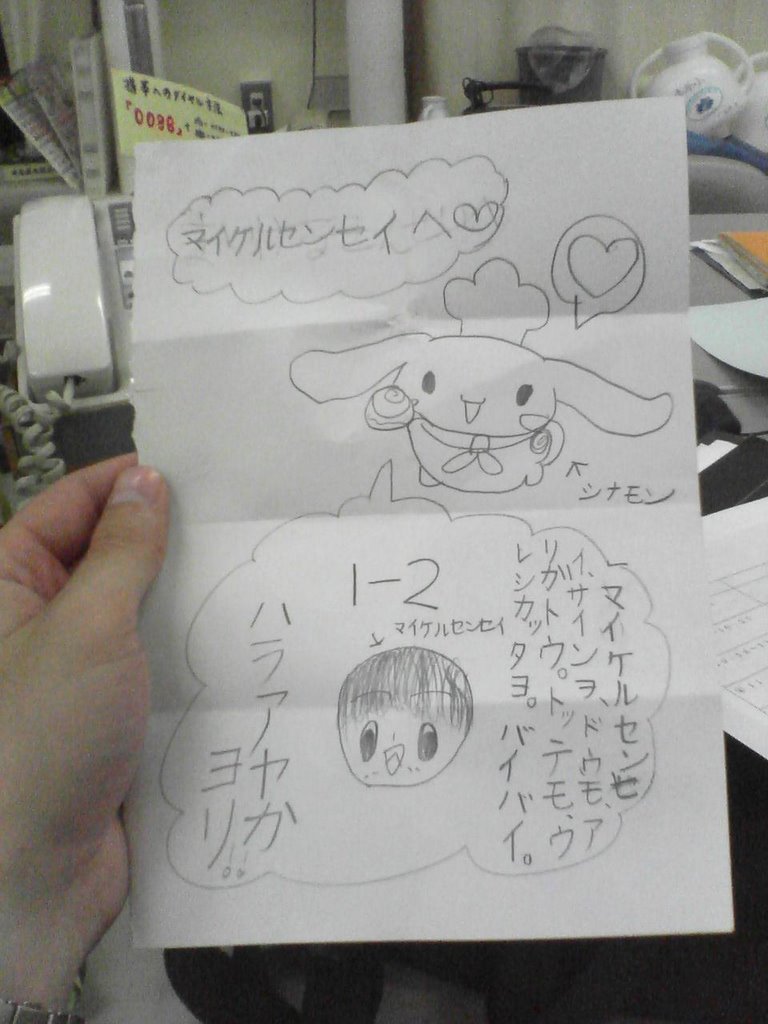Friday, November 03, 2006
I've been spending a lot of time studying Japanese recently.
Sundays, I go to a community center where many foreigners gather and some Japanese volunteers teach Japanese. My friend and I are the only native English speakers there. Most of the others are Chinese or Philippino. Last Sunday we had a Japanese BBQ instead of class and we sang some songs and made food all afternoon. I spent most of the time playing with 2 adorable kids. One is 4 years old and 1 is in first grade (probably around 6). The 4 year old spoke to me in Chinese as if I understood everything and the 1st grader spoke to me in Japanese. Kids that age are so cute!
Tuesdays my friend and I go to this elderly lady's house and she and her friend give us one on one lessons for an hour and a half. After that we all drink tea and chat for a little while. This is where I learn the most out of all my lessons, because she prepares conversations for me that we read aloud and she uses expressions and idioms I otherwise wouldn't be able to pick up very easily.
Thursdays a couple other foreigners and I go to another community center where some more volunteers teach. This lesson is much smaller but pretty fun. After this we usually grab a beer and chill (I'm usually exhausted by Thursday and completely worn out on Friday). I finally got my first monthly pay check. It was about the size of the paycheck I was getting in the US after taxes.... every 2 weeks. But this paycheck is gonna furnish my apartment so I can get my home theater system back up and running.
Before telling this next story let me explain the Japanese alphabets a little.
First there is hiragana. Hiragana has a letter for each sound you can make in Japanese. There are 5 vowels (a i e o u) pronounced as in Spanish and there are about 9 consonants. Making roughly 46 letters. Hiragana is used for all the Japanese grammatical aspects such as verb endings, particles, and more. Here is Hiragana in Hiragana: ひらがな
Next there is katakana. For every hiragana, there is a katakana equivalent. Some of them look simliar, like ka (hiragana か, katakana カ) but some are completely different like su (hiragana す, katakana ス). Notice how katakana is much more angular and hiragana is smooth and pretty. Katakana is used for foreign words and names. For example, orange -> orenji -> オレンジ. Here is katakana in katakana: カタカナ.
Last but not least is Kanji. Kanji means Chinese character and as you may have guessed, comes from China. There are thousands of characters used for names and all kinds of words and verb stems. Kanji are sometimes very simple, such as one (ichi) 一, or person (hito), 人, but they can get really complicated, such as the character for love 愛. Here is Kanji in Kanji: 漢字.
Here is an example sentence: 今日はマイケルの誕生日です。 This sentence means 'Today is Michael's birthday.' 今日, pronounced kyou, means today. The kanji separately mean Now or This (今) and Day or Sun (日). Then comes the hiragana topic marker は, pronounced wa. This marks 'Today' as the topic. Then comes the foreign name Michael (actually said maikeru マイケル). Then comes the hiragana particle の, pronounced no, meaning possession (like the 's in English). After that comes 誕生日, pronounced tanjoubi, meaning birthday (notice the day kanji again, but with a different pronunciation). Lastly is です, the verb meaning is. This is pronounced desu technically, but usually it sounds more like des.
Okay lesson over. So this Thursday I taught 1st and 2nd graders the numbers 1-20.. after 2nd period, about 20 students mobbed me in the hallway asking for my signature. They all had their little booklets and pencils and they lined up nicely for me to sign each one. One girl asked me to write my name in hiragana (the Japanese alphabet) but I said no, I should write it in Katakana. The concept of katakana's use for foreign names was yet unknown to her, though, so she thought that meant I only knew katakana (being a first grader she had just learned katakana recently herself). So about 10 minutes later after I had finished the signatures, she came back with a little folded piece of paper, handed it to me and ran off.

This is the note she gave me. She wrote the whole thing in katakana (the other teachers thought that was hilarious). It says at the top, 'to Michael sensei <3' and at the bottom left it has her name and 1-2 (grade one class two). The face is a picture of me. The note on the right says 'Michael sensei, thank you for the signature. I am very happy. Bye bye.' Hahaha so cute! I'm not sure who the flying thing is but other people drew it on notes to me too. The note by it says 'shinamon' which might be cinnamon, but who knows. Anyway, thats life here, and that's all for now.
No comments:
Post a Comment